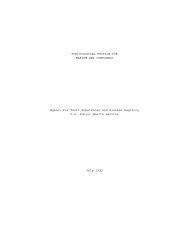Comparison of Disintegration Methods at a Full-scale ... - BVSDE
Comparison of Disintegration Methods at a Full-scale ... - BVSDE
Comparison of Disintegration Methods at a Full-scale ... - BVSDE
You also want an ePaper? Increase the reach of your titles
YUMPU automatically turns print PDFs into web optimized ePapers that Google loves.
METHODS AND MATERIAL<br />
<strong>Disintegr<strong>at</strong>ion</strong> <strong>at</strong> Schermbeck WWTP<br />
Schermbeck WWTP is an activ<strong>at</strong>ed sludge plant with a capacity <strong>of</strong> 17,000 PE. The waste w<strong>at</strong>er<br />
tre<strong>at</strong>ment consists <strong>of</strong> primary settling followed by biological nitrogen and phosphorous removal.<br />
The excess sludge is thickened in a gravity thickener to 25 g/l suspended solids (vol<strong>at</strong>ile suspended<br />
solids: 17 g/l) before being digested together with the primary sludge in two mesophilic digesters<br />
with a retention time <strong>of</strong> 17-18 days. Daily flow <strong>of</strong> excess sludge varies from 12 to 30 m 3 /d. Flow <strong>of</strong><br />
primary sludge is about 6 to 10 m 3 /d with an average concentr<strong>at</strong>ion <strong>of</strong> suspended solids <strong>of</strong> 27 g/l<br />
(vol<strong>at</strong>ile suspended solids: 20 g/l). <strong>Disintegr<strong>at</strong>ion</strong> <strong>of</strong> excess sludge takes place in the influent <strong>of</strong> one<br />
digester. Up to now, there have not been enough long-term experiences about the disintegr<strong>at</strong>ion <strong>of</strong><br />
sewage sludge. Due to th<strong>at</strong> fact, the disintegr<strong>at</strong>ion aggreg<strong>at</strong>es with the exception <strong>of</strong> the ultrasonic<br />
homogeniser only worked for five days a week. To ensure a continuous effluent from the gravity<br />
thickener as well as a continuous influent in the digester, two storage tanks were installed in front<br />
<strong>of</strong> and behind the disintegr<strong>at</strong>ion aggreg<strong>at</strong>e.<br />
<strong>Methods</strong> <strong>of</strong> Sludge <strong>Disintegr<strong>at</strong>ion</strong><br />
Stirred Ball Mills consists <strong>of</strong> a cylindrical grinding chamber which is almost completely filled with<br />
grinding beads. A rotor forces the beads into a rot<strong>at</strong>ional movement. The micro-organisms are<br />
disintegr<strong>at</strong>ed between the beads by shear and pressure forces. For a continuous oper<strong>at</strong>ion the beads<br />
are held back by centrifugal forces and an additional sieve. This kind <strong>of</strong> mill is called disk mill<br />
system and was investig<strong>at</strong>ed in Schermbeck (Type LME 50 K, Netzsch Feinmahltechnik GmbH).<br />
The motor r<strong>at</strong>ing was 37 kW. Circumferential speed <strong>of</strong> the rotor was set <strong>at</strong> 15 m/sec. The grinding<br />
chamber kept a volume <strong>of</strong> 52.8 l. About 85 % <strong>of</strong> the grinding chamber were filled with grinding<br />
beads, which were <strong>of</strong> a different m<strong>at</strong>erial and diameter (SAZ-balls/600-800 µm and zirkonsand/150-250<br />
µm).<br />
For the annular chamber mill the grinding chamber is made up <strong>of</strong> two double cylinders.<br />
Separ<strong>at</strong>ion <strong>of</strong> the grinding beads is achieved by centrifugal forces alone. A stirred ball mill from the<br />
company Draiswerke (Type Cosmo 25), also investig<strong>at</strong>ed in Schermbeck, makes use <strong>of</strong> this method.<br />
The motor r<strong>at</strong>ing was 30 kW. The grinding chamber was smaller and kept a volume <strong>of</strong> about 8.5 l.<br />
Circumferential speed <strong>of</strong> the rotor was set <strong>at</strong> 22 m/sec.<br />
Chemical <strong>Disintegr<strong>at</strong>ion</strong> with Ozone: Due to ozone tre<strong>at</strong>ment cell walls <strong>of</strong> micro-organisms are<br />
disintegr<strong>at</strong>ed and inner cell products can be released. In addition ozone reacts with organic<br />
compounds th<strong>at</strong> are less biodegradable, oxidising them to smaller compounds which are bioavailable.<br />
In Schermbeck a plant for ozone tre<strong>at</strong>ment was made available from the company<br />
Wedeco. It consisted <strong>of</strong> a storage tank for oxygen, an ozone gener<strong>at</strong>or (maximum power r<strong>at</strong>ing<br />
7.5 kW), and a reaction tank <strong>of</strong> 6 m 3 volume. A maximum ozone load <strong>of</strong> 1 kg O3/h could be<br />
gener<strong>at</strong>ed. Ozone was inserted by an injector in the reaction tank bypass.<br />
The Lys<strong>at</strong>e-Centrifugal-Technique uses a thickening centrifuge equipped with a disintegr<strong>at</strong>ion<br />
device loc<strong>at</strong>ed <strong>at</strong> the discharge <strong>of</strong> the thickened sludge. Tools on the rotor and the st<strong>at</strong>or stress the<br />
sludge by shear-forces. Additional energy needed for the disintegr<strong>at</strong>ion is low. But this results in a<br />
very low degree <strong>of</strong> disintegr<strong>at</strong>ion. A lys<strong>at</strong>e centrifuge from the company Hiller (Type<br />
DECATHICK DT31-422) was investig<strong>at</strong>ed for four months. Motor r<strong>at</strong>ing was 15 kW. The number<br />
<strong>of</strong> revolutions <strong>of</strong> the drum was 8500 per minute with a maximum flow <strong>of</strong> 10 m 3 /h. During the<br />
research project only the effect <strong>of</strong> disintegr<strong>at</strong>ion and not the effect <strong>of</strong> thickening sludge were to be<br />
investig<strong>at</strong>ed. For this reason the thickened sludge was diluted again with centr<strong>at</strong>e w<strong>at</strong>er. This was<br />
the only possibility for comparing the two digesters with similar hydraulic retention times.<br />
Ultrasonic Homogenisers consist <strong>of</strong> three major components. A gener<strong>at</strong>or supplies a highfrequent<br />
voltage. A ceramic-crystal <strong>of</strong> piezo-electrical m<strong>at</strong>erial transforms electrical into<br />
mechanical impulses, which are transmitted by a sonotrode into the fluid. Cavit<strong>at</strong>ion bubbles are<br />
cre<strong>at</strong>ed by altern<strong>at</strong>ing overpressure and underpressure (Müller, 2000). The following implosion <strong>of</strong><br />
the gas and vapour-filled bubbles leads to high mechanical shear-forces which are apt to<br />
573
















